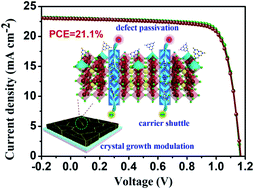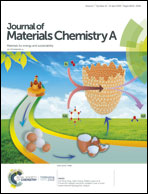Enhanced efficacy of defect passivation and charge extraction for efficient perovskite photovoltaics with a small open circuit voltage loss†
Abstract
Suppressed charge recombination and facilitated charge collection are critical for achieving perovskite solar cells (PSCs) with improved efficiency and stability. Herein, a multifunctional 2D polymeric semiconductor is incorporated into perovskite ink to assist the crystal growth of perovskite films with large grains and fewer defects. Anchoring heterogeneous polymeric molecules on perovskite not only enhances the efficacy of defect passivation at the grain boundaries and/or surface but also facilitates the charge extraction and collection, as evidenced by thermal admittance spectroscopy and femtosecond transient absorption spectroscopy. Accordingly, the PSCs incorporated with a polymeric semiconductor achieve power conversion efficiencies (PCEs) up to 21.1% (aperture 0.16 cm2) and 19.5% (aperture 1.0 cm2), featuring an illustrious open-circuit voltage of 1.16 V (corresponding to a small voltage loss of 0.39 V) and an improved device operational stability (∼90% initial efficiency retained after constant one sun illumination for 500 h). This work highlights the effectiveness of using multifunctional passivation agents capable of providing surprisingly robust efficacy in defect passivation of perovskite, which are also advantageous to crystal growth modulation and carrier dynamic management for efficient and stable PSCs.

- This article is part of the themed collections: 2019 Journal of Materials Chemistry A Most Popular Articles and International Year of the Periodic Table : From Pb and Sn Perovskites to the Next Generation


 Please wait while we load your content...
Please wait while we load your content...